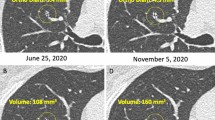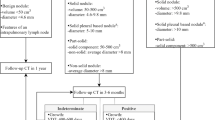Abstract
Objectives
To evaluate the performance of low-dose CT (LDCT) screening for lung cancer (LCA) detection in an Asian population with diverse risks for LCA.
Materials and methods
LCA screening was performed in 12,427 symptomless Asian subjects using either LDCT (5,771) or chest radiography (CXR) (6,656) in a non-trial setting. Subjects were divided into high-risk and non-high-risk groups. Data were collected on the number of patients with screening-detected LCAs and their survival in order to compare outcomes between LDCT and CXR screening with the stratification of risks considering age, sex and smoking status.
Results
In the non-high-risk group, a significant difference was observed for the detection of lung cancer (adjusted OR, 5.07; 95 % CI, 2.72–9.45) and survival (adjusted HR of LCA survival between LDCT vs. CXR group, 0.08; 95 % CI, 0.01–0.62). No difference in detection or survival of LCA was noticed in the high-risk group. LCAs in the non-high-risk group were predominantly adenocarcinomas (96 %), and more likely to be part-solid or non-solid compared with those in the high-risk group (p = 0.023).
Conclusions
In the non-high-risk group, LDCT helps detect more LCAs and offers better survival than CXR screening, due to better detection of part solid or non-solid lung adenocarcinomas.
Key Points
• In an Asian non-high-risk group, LDCT helps detect more early-staged LCAs.
• CT-detected lung cancers in non-high-risk subjects demonstrate better survival than CXR-detected cancers.
• CT-detected lung cancers in non-high-risk subjects are predominantly part-solid or non-solid adenocarcinomas.
• Mortality benefit of LDCT screening in non-high-risk subjects needs to be investigated.



Similar content being viewed by others

Abbreviations
- LDCT:
-
Low-dose CT
- NLST:
-
National Lung Screening Trial
- CXR:
-
Chest radiography
- OR:
-
Odds ratio
- CI:
-
Confidence interval
- ELCAP:
-
Early Lung Cancer Action Project
- HR:
-
Hazard ratio
- AIS:
-
Adenocarcinoma in situ
- MIA:
-
Minimally invasive adenocarcinoma
- EGFR:
-
Epithelial growth factor receptor
References
Sone S, Takashima S, Li F et al (1998) Mass screening for lung cancer with mobile spiral computed tomography scanner. Lancet 351:1242–1245
Henschke CI, McCauley DI, Yankelevitz DF et al (1999) Early lung cancer action project: overall design and findings from baseline screening. Lancet 354:99–105
Patz EF Jr (2006) Lung cancer screening, overdiagnosis bias, and reevaluation of the Mayo Lung Project. J Natl Cancer Inst 98:724–725
Henschke CI, Yankelevitz DF, Libby DM, Pasmantier MW, Smith JP, Miettinen OS (2006) Survival of patients with stage I lung cancer detected on CT screening. N Engl J Med 355:1763–1771
Bach PB (2011) Reduced lung-cancer mortality with CT screening. N Engl J Med 365:2036, author reply 2037–2038
Henschke CI (2012) Re: inconsistencies in findings from the early lung cancer action project studies of lung cancer screening. J Natl Cancer Inst 104:254–255, author reply 255–256
Aberle DR, Adams AM, Berg CD et al (2011) Reduced lung-cancer mortality with low-dose computed tomographic screening. N Engl J Med 365:395–409
Aberle DR, Henschke CI, McLoud TC, Boiselle PM (2012) Expert opinion: barriers to CT screening for lung cancer. J Thorac Imaging 27:208
van Iersel CA, de Koning HJ, Draisma G et al (2007) Risk-based selection from the general population in a screening trial: selection criteria, recruitment and power for the Dutch-Belgian randomised lung cancer multi-slice CT screening trial (NELSON). Int J Cancer 120:868–874
Pedersen JH, Ashraf H, Dirksen A et al (2009) The Danish randomized lung cancer CT screening trial: overall design and results of the prevalence round. J Thorac Oncol 4:608–614
Infante M, Lutman FR, Cavuto S et al (2008) Lung cancer screening with spiral CT: baseline results of the randomized DANTE trial. Lung Cancer 59:355–363
Lopes Pegna A, Picozzi G, Mascalchi M et al (2009) Design, recruitment and baseline results of the ITALUNG trial for lung cancer screening with low-dose CT. Lung Cancer 64:34–40
Baldwin DR, Duffy SW, Wald NJ, Page R, Hansell DM, Field JK (2011) UK Lung Screen (UKLS) nodule management protocol: modelling of a single screen randomised controlled trial of low-dose CT screening for lung cancer. Thorax 66:308–313
Blanchon T, Brechot JM, Grenier PA et al (2007) Baseline results of the Depiscan study: a French randomized pilot trial of lung cancer screening comparing low dose CT scan (LDCT) and chest X-ray (CXR). Lung Cancer 58:50–58
Progetto MILD Multicentric Italian Lung Detection. Available via http://www.capolmone.org/mild.htm. Accessed 26 Jun 2007
Travis WD, Brambilla E, Muller-Hermelink HK et al (2004) Pathology and genetics of tumours of the lung, pleura, thymus and heart. IARC Press, Lyon
Edge SB, Compton CC (2010) The American Joint Committee on Cancer: the 7th edition of the AJCC cancer staging manual and the future of TNM. Ann Surg Oncol 17:1471–1474
Travis WD, Brambilla E, Noguchi M et al (2011) International association for the study of lung cancer/american thoracic society/european respiratory society international multidisciplinary classification of lung adenocarcinoma. J Thorac Oncol 6:244–285
Villa C, Cagle PT, Johnson M et al (2014) Correlation of EGFR mutation status with predominant histologic subtype of adenocarcinoma according to the new lung adenocarcinoma classification of the International Association for the Study of Lung Cancer/American Thoracic Society/European Respiratory Society. Arch Pathol Lab Med. doi:10.5858/arpa.2013-0376-OA
Sun PL, Seol H, Lee HJ et al (2012) High incidence of EGFR mutations in Korean men smokers with no intratumoral heterogeneity of lung adenocarcinomas: correlation with histologic subtypes, EGFR/TTF-1 expressions, and clinical features. J Thorac Oncol 7:323–330
Aoki T, Hanamiya M, Uramoto H, Hisaoka M, Yamashita Y, Korogi Y (2012) Adenocarcinomas with predominant ground-glass opacity: correlation of morphology and molecular biomarkers. Radiology 264:590–596
Tsubamoto M, Kuriyama K, Kido S et al (2002) Detection of lung cancer on chest radiographs: analysis on the basis of size and extent of ground-glass opacity at thin-section CT. Radiology 224:139–144
Lim HJ, Ahn S, Lee KS et al (2013) Persistent pure ground-glass opacity lung nodules >/= 10 mm in diameter at CT scan: histopathologic comparisons and prognostic implications. Chest 144:1291–1299
Chang B, Hwang JH, Choi YH et al (2013) Natural history of pure ground-glass opacity lung nodules detected by low-dose CT scan. Chest 143:172–178
Kakinuma R, Ohmatsu H, Kaneko M et al (2004) Progression of focal pure ground-glass opacity detected by low-dose helical computed tomography screening for lung cancer. J Comput Assist Tomogr 28:17–23
Min JH, Lee HY, Lee KS et al (2010) Stepwise evolution from a focal pure pulmonary ground-glass opacity nodule into an invasive lung adenocarcinoma: an observation for more than 10 years. Lung Cancer 69:123–126
Devaraj A (2014) Missed cancers in lung cancer screening – more than meets the eye. Eur Radiol
Scholten ET, Horeweg N, de Koning HJ et al (2014) Computed tomographic characteristics of interval and post screen carcinomas in lung cancer screening. Eur Radiol
Acknowledgments
The scientific guarantor of this publication is Kyung Soo Lee. This study received funding from the Korean Foundation for Cancer Research, KFCR-CB-201103. Myung-Hee Shin has significant statistical expertise. Institutional Review Board approval was obtained. Written informed consent was waived by the Institutional Review Board. This is a retrospective case-control study performed at one institution.
Author information
Authors and Affiliations
Corresponding author
Electronic supplementary material
Below is the link to the electronic supplementary material.
Supplemental Table S1
(DOCX 41 kb)
Supplemental Table S2
(DOCX 37 kb)
Rights and permissions
About this article
Cite this article
Yi, C.A., Lee, K.S., Shin, MH. et al. Low-dose CT screening in an Asian population with diverse risk for lung cancer: A retrospective cohort study. Eur Radiol 25, 2335–2345 (2015). https://doi.org/10.1007/s00330-015-3620-8
Received:
Revised:
Accepted:
Published:
Issue Date:
DOI: https://doi.org/10.1007/s00330-015-3620-8



